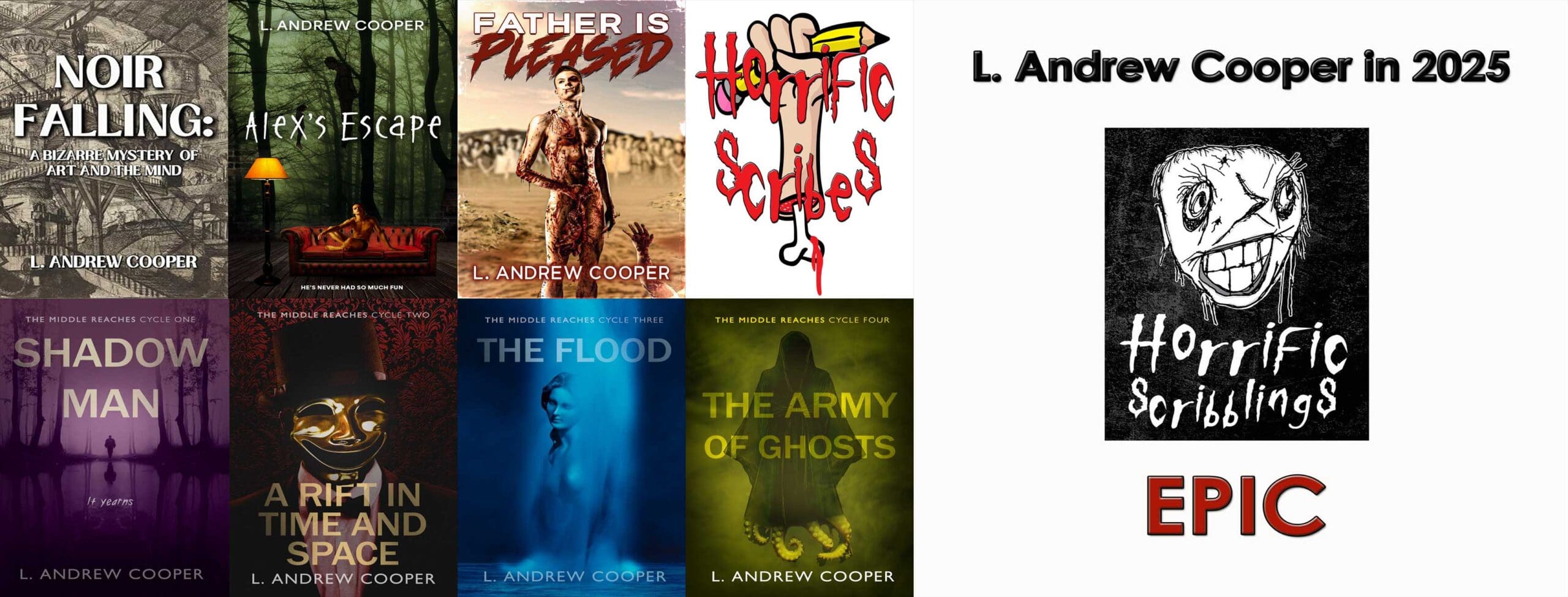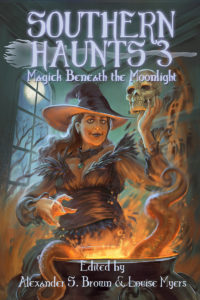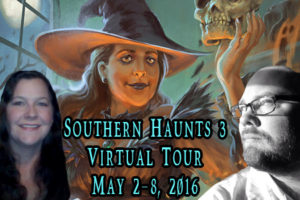Southern Haunts 3: Magick Beneath the Moonlight is a short-fiction anthology that delivers a delectable range of witch-tastic events and images, successfully indulging fantasies of magical power and a fetish for the history of things weird. [For the rest of my review, keep reading, or for an interview with the book’s co-editor Alexander S. Brown, go here.]
Leaving the most familiar questions about whether so-and-so is or isn’t a witch in the background, and saving the typical witch-hunts for Yankee territory, the stories in Southern Haunts 3 presume the existence of magic and focus on the power’s whats and whens. From these whats and whens readers get a sense of a where, the American South, which is both horrific and mystical. As a result, this collection of stories stands apart from typical witch-horror while affirming, in the Southern Gothic tradition, that regular old “realistic” storytelling doesn’t quite get one of the U.S.’s most culturally diverse and historically troubled regions.
While I’m conflating all the mystic goings-on in Southern Haunts 3 as witchery, the collection’s editors and authors are careful to distinguish among types of magic and related spiritual traditions, naming the book’s primary whats distinctly as voodoo, hoodoo, and witchcraft. “The Apartment House,” for instance, provides a series of bizarre and violent tableaux—death by books is my favorite, but a detailed flaying deserves mention—and ties them together with a lesson on the laws for practicing voodoo the right way. In “La Voyante,” a knowing character explains to a writer looking for a new creative outlet that voodoo isn’t the only game in town:
“No, we talkin’ ’bout Hoodoo. Between the ‘hoo’ an’ the ‘voo,’ there’s a worl’ of difference… though we do tend t’ use a bit of both in these parts.”
Often gesturing toward the diasporic and creolized origins of so-called “pagan” spiritualities tied to hoodoo and voodoo, the stories in Southern Haunts 3 provide a nuanced enough view to add an S to the K in the subtitle, making it a less elegant MagickS Beneath the Moonlight (not a suggestion—the actual title is much better!). Indeed, as the main character of “In the Dark” learns, some magic needs to be practiced only in the day, so “moonlight” isn’t even a consistent feature of proper witchery. Magic refuses easy limits, and while it can be as elegant as the kindly title character of “Granny Wise,” it can also be as ugly as characters’ habits in “Dances with Witches.” The collection tells us that all these magics might fit in a book, and they all show up in the South, but they won’t all fit in a proverbial box. The box mentioned in the title “The Priestess’s Trunk,” then, provides an apt metaphor: you might try to contain and understand mystical forces, but magic will always find a way to push beyond easy categories and simple expectations.
Despite the diversity of magical types in Southern Haunts 3, magical power almost always serves one end: payback. While the book draws its power from many veins, it directs that power primarily toward fulfilling fantasies of justice and vengeance (for comments on this focus from one of the book’s editors, see the interview). The first tale, “Granny Wise,” based on a historical figure, sets the mold: a witch serves locals as a healer, but the price of her services includes righting wrongs. In most tales that follow, witchcraft, as a means for payback, either doles out a kind of cosmic justice against evildoers (as, for example, in “Live Big”) or serves as means for a witch to get some vengeance on (as in “Vengeance,” “The Jar,” “Tell Me Where He Lies,” and “Without Xango there is No Oxalla”). The most salient motive for mystical vengeance in Southern Haunts 3 relates to the South’s legacies of racism, slavery, and lynching. In “The Untold Tale of Wiccademous,” searching for the story behind cursed woods leads the would-be storyteller into a cosmic trap forged from these legacies. “Cursed,” set in the 1920s, takes a more direct look at magic providing justice for a lynching that earthly courts would ignore, and “The Shadows” answers a nineteenth-century slave-master’s murder of an innocent man with a curse that takes “life for a life.” While magical means of achieving racial justice help to advance the book’s Southern identity, magic also serves as an equalizer for women who suffer under the arbitrary rule of despicable men. The mystic in “Secrets of the Heart” learns that her husband’s religious hypocrisy too easily stands in the way of his devotion to her, a betrayal she does not suffer lightly; likewise, when a violent husband crosses “The Bone Picker Witch,” he opens the door for some of the book’s nastiest moments. In most cases, mystical vengeance is overwhelming and horrific, but the justification that goes with it makes rooting for magical victory a source of grim pleasure.
While the fantasy of supernatural justice is fun to indulge, it recurs a little too often within the selection of tales, and the stories that rely on it less end up being my favorites in the book. “The Witch of Honey, Kudzu, and Coyotes” shrouds its title figure in mystery, making her more like a force of nature than a person practicing a secret art. Going further with an interest in storytelling that runs through “The Untold Tale of Wiccademous” and several other tales in Southern Haunts 3, “The Witch of Honey, Kudzu, and Coyotes” opens with an interrupted story that persists in the narrator’s imagination “like a hollow, unformed thing” alongside
“a boy missing from everyone’s memory”
Broken stories and memory gaps make magic powerful enough to reshape thought and perception, reweaving reality’s fabric; as a result, this tale can explore fresh and compelling territory. Likewise, “In the Dark” focuses on the perils of exploring the unknown. A bit rambling in structure, this tale brings its unwise protagonist in contact with strange verse, talking birds, and a host of disturbing images—my favorite is a buck with centipedes pouring from its mouth—that again signal a link between magic and distorted perception that can change the rules for what a story can do. Fans of more transgressive and gruesome horror fiction will likely count “In the Dark” and “The Bone Picker Witch” as favorites along with “Docta Bones,” in which the title character inverts Granny Wise’s benevolence by requiring much harsher payment for the gods’ services, and “Dances with Witches,” which places a human appetite for evil in parallel with a bewitched landscape’s. Chilling acts and images become the main products of witchery: questions of justice and the natural order become secondary to experiencing the full horror of the weird.
A volume about magic and the South invites thinking about cultural and regional history, and with stories set in (or focused on rediscovering) the eighteenth, nineteenth, and early twentieth centuries, Southern Haunts 3 does a great job of putting together views of the past (and thus it meets its goals–see the interview). As a Southerner, I wonder about the present. Where is witchcraft in the contemporary South? How do hoodoo and voodoo continue to inform life not just in old New Orleans, but also present-day Atlanta, Richmond, and cities in between with “modern” feels that contrast with the antiquarian interests that dominate this book? The book covers solid ground, but by sticking mainly to historical subjects, it might miss some opportunities for innovation.
The opportunities included, however, add up to a satisfying read. Moody, atmospheric, and drenched in regional detail, Southern Haunts 3 gives readers an entryway to the South’s mystic history, places and times to explore with equal amounts of dread and delight.
Southern Haunts 3: Magick Beneath the Moonlight,
Table of Contents
- “Granny Wise,” by H. David Blalock
- “Live Big,” by Tom Lucas
- “The Priestess’s Trunk,” by C.G. Bush
- “The Witch of Honey, Kudzu, and Coyotes,” by Diane Ward
- “The Untold Tale of Wiccademous,” by J.L. Mulvihill
- “Vengeance,” by Linda DeLeon
- “The Jar,” by Robert McGough
- “La Voyante,” by Elizabeth Allen
- “Cursed,” by Melodie Romeo
- “Secrets of the Heart,” by Louise Myers
- “Tell Me Where He Lies,” by Greg McWhorter
- “Shadows,” by Kalila Smith
- “Docta Bones,” by Melissa Robinson
- “In the Dark,” by Jonnie Sorrow
- “The Apartment House,” by Della West
- “Without Xango There is No Oxalla,” by John E. Hesselberg
- “The Bone Picker Witch,” by Angela Lucius
- “Dances with Witches,” by Alexander S. Brown



Comments are closed.